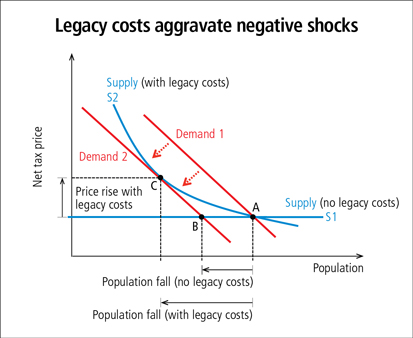Executive summary
Pay-with-promises compensation plans accumulate liability for future employee benefits, such as retiree health insurance. A simple economic model demonstrates that such plans can exacerbate fiscal crises faced by cities that experience external economic shocks, such as the departure of a major employer. City leaders often raise taxes and/or reduce public services to pay off legacy employee debts, and such steps encourage residents to move out, reducing the tax base and raising fiscal stress. Pay-as-you-go compensation plans are more prudent; they settle liabilities to employees paycheck by paycheck.
Introduction
When employees are compensated on a pay-as-you-go basis, accounts are settled paycheck by paycheck, and no future liabilities are implied. In contrast, a pay-with-promises plan means that along with current compensation, an employer accepts a liability to provide some additional benefit (such as retiree health benefits) to the employee. Many U.S. cities include a pay-with-promises component in the pay structure of municipal employees. In our recent Federal Reserve Bank of Minneapolis staff report, we provide a detailed examination of how this kind of pay structure interrelates with the growth of cities.1 This policy paper describes the key issues, summarizes the analysis and discusses our conclusions from that research and their implications for public policy.
Cities face risks of various negative shocks that impact city size and income. We trace through the problems that arise if a city saddled with “legacy” retirement costs associated with pay-with-promises compensation experiences a downturn. We find that the financial distress caused by making good on promises from previous years often leads city officials to increase taxes and cut government services. But these higher taxes and lower government services make the city a less attractive place to live, causing more people to leave, compounding the problem as the city tries to raise necessary revenues from a decreasing population base. This dynamic between declining city size and higher taxes and lower services is often referred to as a city death spiral.
Detroit is the classic example of a death spiral. This city has certainly suffered negative shocks, particularly by the decline of Michigan’s automobile industry. Well-known commentator Paul Krugman has gone so far as to say that “for the most part the city was just an innocent victim of market forces.”2 We agree that market declines create adverse shocks for cities, but those shocks have been substantially exacerbated because of Detroit’s pay-with-promises commitments to city employees. In the face of these liabilities, Detroit has imposed the highest tax rates in the state and provided shockingly abysmal government services, illustrated by the fact that 40 percent of the streetlights are not working. Population has declined 26 percent since 2000. The term death spiral is now well-known throughout Michigan, but particularly in reference to Detroit. Even the city manager has admitted: “We are in a death spiral.”3
Before getting into specifics, we would like to highlight two features of our paper. First, it provides a simple, formal economic model that we use to evaluate policy questions. While much of the economics underlying our analysis is quite intuitive, working through the issues in a formal model clarifies subtle questions. For example, what are the effects of pay-with-promises schemes when they are completely funded in an “expected value” sense? In other words, what if a city invests money to fund a future benefit, but agrees to absorb investment risks (up or down) by funding any shortfall between promised pay and actual investment return? We show that it is more efficient to use a strict pay-as-you-go system, in which accounts are settled paycheck by paycheck.
As another example, does it make a difference in the analysis whether municipal workers are unionized? Again, this is a subtle question, because nonunion municipal workers, as well as unionized employees, are often compensated under pay-with-promises plans. A formal model helps isolate the specific role of unions in such situations; we come back to this below.
The second feature to highlight is the central analogy in the paper between a firm trying to attract customers and a city trying to attract residents. In both cases, there is downward-sloping demand: A firm that raises its price (or makes a worse product) loses customers; a city raising taxes (or reducing services) loses residents. Economies of scale may exist for cities, just as they do for firms, from “producing” at higher levels. The case is evident for firms. In the example of a city, providing schools or roads for more residents means a lower average legacy burden per resident. And both firms and cities are subject to demand shocks. Analogous to the way fixed legacy costs are a problem for a firm facing declining demand, they are a problem for a city facing declining demand.
In recent years, private sector firms have moved away from pay-with-promises schemes to pay-as-you-go. For example, private firms now typically contribute to employee 401(k) retirement plans, rather than making the long-term commitments that come with traditional pension plans. Would a similar move make sense for cities as well? Our analysis leads us to believe so.
The qualitative similarities between cities and firms just described suggest that the economic logic for pay-as-you-go compensation applies to cities just as it does to firms. Yes, there are quantitative differences between firms and cities. And we expect the demand faced by a firm to be often more elastic than the demand faced by a city. (It is easier to switch the brand of cars you buy than change where you live.) Yes, the possibility of negative demand shocks may be larger for firms than cities. (The negative shock to Blockbuster of the decline of the videotape rental business obviously was more severe than the negative demand shock to Detroit.) Nevertheless, these are differences in degree, not kind.
Some specifics
Cities face a demand curve for residents. The price for any individual to live in the city includes the cost of any taxes that will need to be paid to reside there. In our analysis, we subtract the value of services the individual receives (e.g., street lights, police protection) from these taxes and call this the net tax price of living in a city. As in textbook Econ 101, the lower this price, the greater the quantity of demand. (Here, if the net tax price of city life declines, more residents are willing to move in.) This effect is considered moving along a demand curve.
In contrast, broad factors like the general quality of job and cultural opportunities and amenities like good weather affect demand patterns differently; rather than causing a move up or down an existing demand curve, they actually shift the demand curve altogether. For example, if the primary industry of a city collapses, this is considered a downward shift in demand. If a major corporate employer relocates operations to the city, that might shift demand outward.
Next, we determine what is feasible for the city to offer and construct the analog of a firm’s supply curve. We’ll refer to this as an “average” net-tax-price curve, because it will be calculated on a per capita basis.
There are four parts to the average net tax price:
|
Average net-tax-price curve |
= |
legacy cost / population |
(part 1) |
|
|
+ |
(service x wage) / productivity |
(part 2)
|
|
|
+ |
tax distortions |
(part 3) |
|
|
– |
value of service |
(part 4) |
Part 1 equals existing “legacy” costs (i.e., unfunded promises to retirees) divided by population. Legacy costs are fixed, and the greater the current population, the lower the legacy burden on a per capita basis.
Part 2 equals current per capita expenditures for the current level of government services. This component increases if a city raises service levels or public sector wages and decreases if the opposite occurs. It is lower if public sector productivity is higher.
Part 3 takes into account distortions created by taxation. For example, if a city imposes a higher tax on homeowners if they remodel their property, the homeowners may choose not to go ahead with the improvements. If a city imposes an income tax, a resident may decide to work fewer hours to earn less income. These distortions destroy value and, ultimately, the losses are passed along to the residents who pay the taxes.
Finally, part 4 nets out the value of the public services a resident enjoys in the city, as described earlier.
In the accompanying figure, we’ve illustrated two cases of an average net-tax-price curve that combines all four components. These two curves, in blue, are labeled “Supply.”
In the first case, there are no legacy costs, and the resulting supply curve is perfectly flat (S1). As a result, adding people does not change the tax situation at all on a per capita basis. In the second case, there are substantial legacy costs (S2). Here the curve is sharply downward-sloping, as the overhead costs are spread across additional people—that is, a higher population enables a city to charge each resident a lower per capita tax, as the total costs of providing city services are divided among more people. (Note that in standard textbook analysis, supply curves are upward-sloping, because as a market expands, firm costs rise because firms have to buy their supplies from higher-cost sources, thereby pulling up their average costs of manufacturing. But for a city with high legacy costs, higher volume pulls the per capita burden down.)
Both blue supply curves are drawn such that the equilibrium (where supply and demand meet) at the initial demand curve (Demand 1) is at the point labeled “A.”4 Now suppose the city experiences a negative shock, such as a decline in the local industry, shifting demand downward, as illustrated by the arrows shifting the demand curve to the Demand 2 position.
With no legacy costs, population declines to the equilibrium at B. With legacy costs, the population decline is sharper, as the initial effect of the decline in (labor) demand is magnified by additional exit induced by the higher net tax price (a result of both higher taxes and cutbacks in services, such as fewer streetlights). Equilibrium is at C: lower population and higher net tax price. This is a graphical illustration of a death spiral effect.
Issue analysis
We use this framework to examine the two issues mentioned above: whether the unionization of municipal employees makes a difference to a city’s financial picture and whether it’s financially prudent to adopt pay schemes that absorb investment risk when depending on investment returns to fund promised benefits.
As noted above, pay-with-promises compensation schedules can be found for both union and nonunion municipal employees. For this analysis, a key point is that unionized workers tend to get both a higher level of current wages and higher promised benefits. This results in a higher level of legacy costs, which shifts up the supply curve and makes it steeper. With a steeper supply curve, the death spiral magnification effect of a demand downturn becomes even more prominent.
Another potential effect of unions is through the productivity variable that appears in the second term above. Collective bargaining agreements for Detroit’s workers, for example, have imposed standard union work rules and work practices impeding management rights.5 These work rules can reduce productivity. Reduced productivity shifts up the supply curve (see part 2 above), which makes the city less attractive, shrinking the equilibrium size of the city.
Second, we consider policies that attempt to fully fund (in an “expected-value” sense) future promised benefits, but leave the city on the hook for any deviations between actual returns and expected value. For example, suppose the city offers a defined benefit plan with specified annuity benefits. If the city’s investment returns are high, legacy costs will be relatively low since the returns fund a high percentage of legacy cost payments; however, if investment returns are low, then legacy costs will be relatively high.
Our model and graph illustrate the effect on city growth: If the pension bet is favorable for the city, then the supply curve shifts down and city size expands. If the pension bet is unfavorable for the city, the supply curve shifts up and city size contracts. Evidently, having the size of a city depend upon the outcome of a pension bet is not a very sensible way to run a city, and our formal analysis provides justification for this position.
Rather than impose these risks on municipal governments, it makes sense to find insurance products sold by financial intermediates with the capacity to absorb investment risks. (For example, annuity contracts that look like defined-benefit contracts.) The only difference would be that municipal governments would be off the hook for future commitments—out of the insurance business and better off for the change.
As noted up front, there is an analogy here between a city and a firm; a city can attract residents with low taxes and high service quality just as a firm can attract customers with low prices and high product quality. And cities, like firms, experience demand shocks. Thought of in this way, the recent bankruptcies of General Motors and the city of Detroit have much in common (aside from their close relationship). Both institutions were saddled with huge legacy costs from employee compensation commitments and inefficient work practices. Both experienced negative demand shocks. As part of its restructuring, General Motors has cut back on inefficient work practices and moved close to a “pay-as-you-go” model. To the extent that Detroit also moves in this direction, it will be more resilient in the face of future shocks.
This essay has focused on municipal finance, but our discussion of legacy costs of earlier pay promises may bring to mind national-level legacy costs from promises made to U.S. citizens regarding Social Security and Medicare. We emphasize two important differences between the local and national level. First, it is much easier for individuals to relocate locally than nationally. In fact, at the local level, individuals may be able to switch the municipality where they live without changing jobs. Mobility—where individuals can move to escape legacy costs—played a key role in our discussion.
Second, at the national level, it is more likely that economic shocks average out, compared with the local level. (A bad shock to industry A in city X may be offset by a good shock to industry B in city Y). So, while our arguments apply with most force at the municipal level, they have bite even at the national level. Firms are internationally mobile—far more so than employees—and if federal corporate tax rates are set at high levels to pay retiree legacy costs, some firms may choose to go abroad.
Conclusion and closing observation
In summary, this essay has made a case for cities to use pay-as-you to compensate their employees. As a city with legacy costs collapses into a vicious cycle of decline, it may become all the more tempting to try to pay workers with promises. Empty city coffers make it difficult to do anything else. Yet this only compounds the problem in the long run. A city may have an opportunity to dig its way out of a current hole by restructuring debt. By changing the way a city compensates its employees, it can lower the probability of getting into trouble the next time.
In fact, just as we put finishing touches on this essay, there was an announcement that Detroit is restructuring its pension system into a hybrid of a defined-benefit and a defined-contribution system.6 At this point, details are sketchy, but a key aspect of the plan appears to be the use of various mechanisms to insulate taxpayers from absorbing risks of variations in future investment returns. In other words, the plan purportedly moves in the direction of the kind of pay-as-you-go system that we have argued for here.
Endnotes
1 See “Pay with Promises or Pay as You Go? Lessons from the Death Spiral of Detroit,” by Thomas J. Holmes and Lee E. Ohanian, Staff Report 501, Federal Reserve Bank of Minneapolis, July 2014.
2 See “Detroit, the New Greece,” by Paul Krugman, New York Times, July 21, 2013.
3 Detroit Emergency Manager Kevyn Orr, as quoted by Fox News, June 15, 2013. See “Detroit to Default on $2.5B Debt to Avoid Bankruptcy, Emergency Manager Says." See also “How Do Cities Get in a ‘Death Spiral,’ and How Can We Stop It?” on Michigan Radio, Nov. 21, 2013.
4 At A, the slope of the demand curve is steeper than that of the supply curve. Curves can also intersect at points where the supply curve is steeper. However, supply always flattens out and intersects demand at some other point like A where demand is steeper. In our companion staff report, we explain why we focus on cases like A.
5 As explained in the city of Detroit’s, “Proposal for Creditors,” June 14, 2013, employees have held “bumping rights,” allowing them “to transfer across departments based solely on seniority (without regard to merit, relevant qualifications, or experience in the new position).” There have also been standard limitations on management’s right to “revis[e] and eliminat[e] job classifications” and “to implement and modify disciplinary policies.”
6 See “Detroit Rolls Out New Model: A Hybrid Pension Plan,” by Mary Williams Walsh, New York Times, June 18, 2014.







